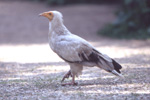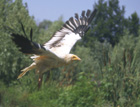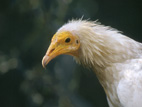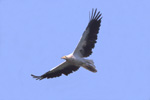|
|
|

|
|
|
|
The Forgotten bird
|
|
Egyptian Vulture
|
|
|
|
Text and photos by Ernesto Francini
|
|
|
|
|

|
|
Egyptian vulture
(Neophron percnopterus).
|
|
|
|
|
In silence, sadly it is disappearing, with the
dignity of whom doesn't want to disturb, as if it was aware of the
indifference of the man towards it, the Egyptian vulture, the smallest
European vulture, is going slowly toward the extinction.
It would like to say us that we are doing
too few things for its survival, that the things done, till now, have not
been enough, that once it had respect and protection from our progenitors,
while today it is only an unknown or ignored animal for the most greatest
part of the people.
And my thought goes still instinctively to
remember the good sense of our ancestors, which, aware of the importance of
the nature, they respected it and they understood it more than us today. As
to indicate that the man's evolution, reaching unexpected goals through the
technological progress, causes a loss of wisdom of the human being.
The vulture of the ancient Egyptians, so
also called , since already at the time of this civilization it was
appreciated for its quality of nature sweeper; eating carrion of deceased
animals and organic rubbishes contributed to maintain the man estranging
from the pestilences and illnesses.
Revered to such point to become one
of the ideograms of the Egyptian hieroglyphic alphabet, still today visible
on the obelisks and in the frescos of the Pharaoh graves, now it is
disappearing forever from our territories.
|
|
|
|

|
|
Egyptian vulture
ancient effigy.
|
|
|
|
|
An intelligent vulture, solitary, calm,
silent, whose proximity a sensation of serenity gives me, the same feeling
that is tried when a trusted friend is near to us.
With length between 53 and 65 cm, it
has a pure white plumage with the wings having blackish primary remiges.
The head and the throat have yellow naked skin to whose base detaches a
whitish hairy collar and its wings opening is of 1,6 mt. about.
It possesses a very agile flight with sudden
turns, glides, and quick ascents of altitude.
Its great agility in the flight allows it to
face and to compete, for the control of the territory, with others fast
birds as the Buzzard (Buteo buteo) the Red kite (Milvus milvus) and the
Raven (Corvus corax).
|
|
|
|
Smaller than the
other european vultures as Griffon (Gyps fulvus) and the Bearded (Gypaetus
barbatus) it’s satisfied with very little eating foods, that these
vultures, bigger than it and with which cannot have a confrontation, leave
on the ground. Endowed of a thin bill as a " finisher " that
allows it to dig between the bones of the dead animals, where the others
cannot arrive.
It is fed of
deceased animals and it never attacks alive, wild or domestic animals.
It is also nourished
of placentas left by the livestock on the ground, vegetables and rotten
fruit, insects and eggs.
It knows how to use
utensils, as only few birds are able to do, to obtain food.
When it desires to
feed with eggs, but these have a resistant shell, it uses a stone. Holding
it up in the bill it lets it to fall down repeatedly on the shell to get
its breakage.
|
|
|
|

|
|
Egyptian vulture (Neophron
percnopterus) in glide.
|
|
|
|
|
It frequents
mountainous open zones mainly or lowlands destined to the pasture of
livestock at the wild state.
Migratory, it winters in Africa to south of the
Sahara and it returns in southern Europe during the spring season to
nest.
It builds the nest on hollow or windowsills
of isolate impregnable rocky walls, that allows it a vast visual control of
the territory, so that it can individualize the rests of deceased animals
quickly. It possesses a very acute sight and it has the exceptional ability
to discover also food of small dimensions.
The nest is a
branches heap of different greatness and it is internally garnished with
wool of sheep and other soft material.
The mating happens in the nest
proximities and it is preceded by spectacular flights of parade in dive and
in glide.
The female deposes 1 or 2 eggs of
white color and they are incubated then by both the adults for around 42
days.
After the birth the chicks have fed
from both its parents and they remain in the nest for around 80-90 days,
after which they fly away.
The births are programmed so that the
take-off of the young birds from the nest happens in the month of August,
before undertaking the migration toward the winter districts that it
usually happens in September.
|
|
|
|
|
|

|
|

|
|
Egyptian vulture
(Neophron percnopterus).
|
|
Egyptian vulture
(Neophron percnopterus)
|
|
|
|
close-up.
|
|
|
Completely extinct
in the north Italy, it survives only with few exemplars, about ten pairs,
in the south of the country, while in the rest of Europe it is in strong
decline.
The reasons for this
decline are once more attributable to the man.
Decimated by the poaching, from the wild
hunting in proximity of the nest-building areas
to get as trophy a bird become now rare,
from the almost disappearance of the wild pasture replaced by the most
profitable breeding in the farms, from the poisoning of dead livestock to
keep further the raiders as the wolf and the fox.
The Egyptian
vulture, in Italy, it is often forced to feed in the rubbish dumps.
As consequence of this we have reached to
such point that, if, in our country, drastic measures won't be taken
immediately for its protection and safeguard, within few time it will be
extinct surely.
To avoid its disappearance is necessary to
have new Italian centres for the reproduction in captivity; the actual
reproduction cannot be founded on few centres and few exemplars only.
I realize that the thing it is not easy to be
effected, but I am also sure that the nature salvation, on this planet, it
will pass only through the stubbornness and the passion of irreducible men, which won't be
stopped in front of the obstacles that they will find on their way.
It’s therefore necessary to increase the
number of the unities destined to the reproduction in captivity and to
release as soon as possible, on the whole national territory, a number of
born birds more great, installing in the oases opportune mangers where
these birds can feed in case of scanty availability of food.
If every national park and every protected
oasis of the Italian territory decided to adopt
a pair of Egyptian vultures and they will
provide for its reproduction in captivity, for then
to release the new
born in nature, they would have given a great contribution against the
extinction of this necessary bird.
In this manner they
will have contributed to adorn and to repopulate the fauna of their own
region and of the whole our country, and, surely, the Egyptian vulture will
compensate us for this.
|
|
|
|

|
|
The Pharaoh can
ascend to the sky
|
|
assuming the
features of an Egyptian vulture.
|
|
|
|
|

|
|
Egyptian vulture
(Neophron percnopterus) in flight.
|
|
|
|
|